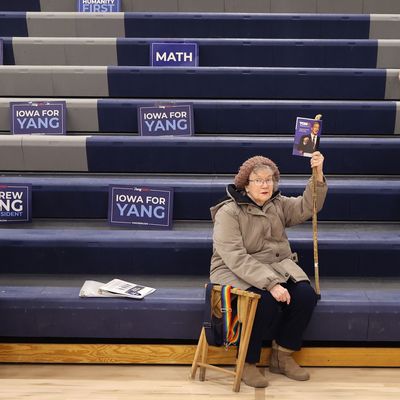
The endless uncertainty over the results of the Iowa caucuses has partially obscured one outcome that is not in dispute: Turnout was disappointing.
To be clear, the number of people caucusing was not down from the last competitive event in 2016, which drew 171,517 Democrats. Turnout this time around was 176,436. But it did not come even close to the 239,000 who caucused in 2008. And that was an unwelcome surprise to those who thought the large field, the evidently close race, and above all, Democratic enthusiasm about the prospect of beating Trump, would combine to produce a bumper crop of caucusgoers.
But no dice.
There are interpretations for this phenomenon that are relatively comforting for Democrats, as Iowa Starting Line observes:
Megan Suhr, the former chair of the Marion County Democrats, wasn’t surprised when her caucus site saw lower turnout than 2016. She expected the result. She knocked doors before the caucuses and said she mostly encountered people who said they would vote for whoever the nominee is in November.
“There were a lot of different reasons and explanations,” Suhr said. “There were also a lot of people who said they’d been watching all the hearings and they were watching the trial, and to them, whoever the caucus-goers decided, whoever came out of the primaries, was who they were going to support in the fall.”
A similarly benign explanation is found in the unusually high number of undecided voters most polls of Iowa were showing. In a primary, an undecided voter can carry doubts right into the booth and quietly make a private decision. At a caucus like Iowa’s, you must quite literally go sit or stand with supporters of a candidate. If you’re not sure, it’s hardly irrational to stay home, even if you are 100 percent sure to vote in November.
But there are, of course, darker interpretations, such as the one David Axelrod — who knows Iowa very well — told the Daily Beast:
“As a citizen, am I worried about it? Yeah. Especially after the explosive turnout of ’17 and ’18,” said David Axelrod, who helped spearhead the historic Barack Obama Iowa caucus win in 2008. “There are more benign explanations, like it is a caucus and the candidates were in Washington and not there to stir up the turnout. But there is another possibility, which is that people just felt dispirited. That’s a danger for Democrats. The Trump effort is infused with cynicism. And propagating cynicism can be a powerful tactic if you’re trying to depress an opponent’s turnout.”
“That is a big concern,” he added, “that a dispirited electorate, beaten and burnt out, just walks away.”
It’s notable, too, that turnout varied by the nature of the precinct:
This would reinforce an interpretation that Trump is turning some rural areas of Iowa deeper red than in the past. And that in turn is particularly concerning news to the campaign of Bernie Sanders, whose electability argument all along has been that his populist appeal will bring back some of the white working-class voters lost to Trump in 2016. There’s not much evidence of that part of Iowa responding to Bernie 2020; his support was heavily concentrated among younger voters in cities. Then again, he could boast that he had boosted youth turnout, well above 2016 levels and even beating the Obama-fueled 2008 caucuses.
The peculiar nature of Iowa and its arcane processes makes long-term projections based on turnout in the caucuses questionable. But whether it has anything to do with Iowa or not, New Hampshire has now lowered its earlier very high turnout estimates for its primary on February 11 from 500,000 to 425,000. That would still represent the highest turnout level ever in an election involving an incumbent president. But it does not reflect the vision many once had of Democrats and independents and ex-Republicans mobbing the polls to choose a champion to drive the evil king from the throne in Washington. Given how excited the MAGA hordes seem to be, that needs to change — if not during the primaries, then in November.






























